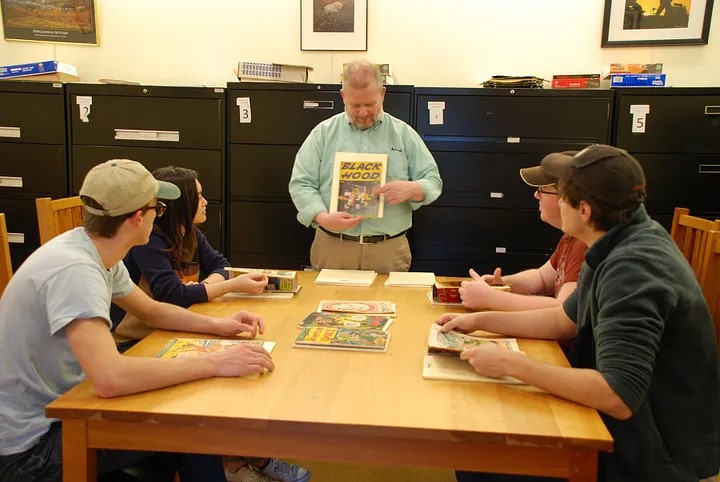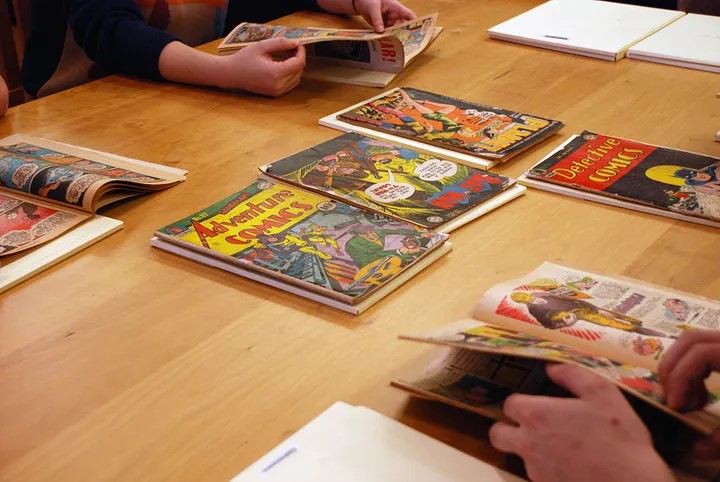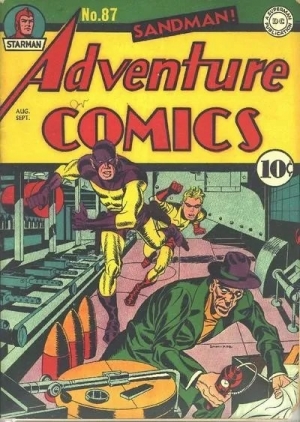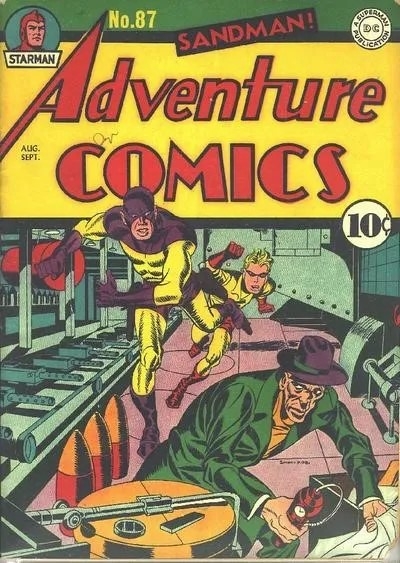This is a guest post by Dr. Craig Fischer, Professor of English at Appalachian State University.
I’ve been a comic book fan for almost half a century — just ask my poor parents, who I bullied into buying me a comic every time we went to the supermarket or the drugstore — but it’s only recently that I’ve brought my love of the comics medium into the classroom.
A few years ago, I taught a seminar in comics and graphic novels to sophomore Honors students, and the class was popular: I taught it three more times at full enrollment in the Honors College, and my home department of English made my comics class a permanent part of the curriculum in fall 2016. Seeing “English 2180: Introduction to Comics and Graphic Novels” in our course schedule, next to classes on Shakespeare and critical theory, reminds me just how much comics have shed their earlier status as lowest-common-denominator cultural trash. When I was a kid, reading comics defined me as a nerd and a loser. Nowadays, being a nerd is cool (I’m finally cool!), and scholars race to write articles about such highly esteemed graphic novels as Art Spiegelman’s Maus: A Survivor’s Tale (1980–1991) and Alison Bechdel’s Fun Home (2006).
Last November, as I was wrapping up my first semester of English 2180, I received an e-mail from Greta Browning, a librarian and curator in Belk Library and Information Commons’ Special Collections Research Center. Greta informed me that we had a small batch of Golden Age comics in Special Collections, available for use in my class if I were interested. Oh, I was plenty interested! Golden Age comics — those published during the earliest days of the comic book, from the late 1930s to the late 1940s — are exceedingly rare, and I lunged at the opportunity to give my students access to such seminal but hard-to-come-by comics. When I saw the specific comic books that are part of the Belk Library Golden Age collection, I immediately thought of dozens of ways I could integrate them into my teaching, and Greta and I organized my class of 32 students into smaller groups that visited Special Collections to look at samples of the Birth of the Comic Book.

Dr. Craig Fischer discusses the cover of the Black Hood comic volume 1, number 14, with his students. The cover is drawn by Everett Raymond Kinstler, who later in his career would become a fine artist, and the painter of official portraits of Presidents Gerald Ford and Ronald Reagan. Small groups of Dr. Fischer’s English 2180 students visited Special Collections Research Center the week of February 20, 2017, to have a hands-on experience with the books.

One example from the collection that Greta and I shared with the class was Adventure Comics #87 (August 1943). Its vivid cover shows two gangly superheroes (The Sandman in the purple hood, accompanied by his sidekick Sandy) racing to stop a saboteur from blowing up a machine-gun factory. If you look under the saboteur’s left arm, you’ll see a small creative credit, “Simon + Kirby,” two names intimately familiar to comics fans and scholars.
Joe Simon and Jack Kirby were two of the most important creators of comics’ Golden Age. They began their collaboration in 1940, with Kirby writing and drawing stories, and Simon acting as a liaison with comic book companies, though he’d occasionally help Kirby with the creative chores. In 1941, the duo co-created Captain America for Timely (later Marvel) Comics. After a budget dispute with Timely publisher Martin Goodman, Simon and Kirby defected to DC Comics, where they came up with popular WWII characters like Manhunter and the Boy Commandos. During the DC period, Simon and Kirby also started a “sweatshop,” an assembly-line studio of younger cartoonists who could crank out pages quickly for various publishers. Consequently, some of the DC comics signed “Simon + Kirby” are ghost-drawn by other hands, but the Sandman story and art in Adventure Comics #87 are pure Kirby.
Why are Simon and Kirby so significant? First, the comics they wrote and drew during their fifteen-year partnership are much better than the grind-it-out stories common in comic books during the 1940s. (It’s only a select minority of comics published during this period that really deserve to be called “Golden.”) Kirby’s superheroes are models of expressive anatomy — his heroes move in balletic, explosive ways when clobbering Nazis and masked villains — and Golden Age Kirby pages vibrate with jittery energy. Not enough of the Simon and Kirby output is currently available (a Sandman reprint collection from Titan Books has been out of print for several years), but thanks to Greta and Belk Library, my students had the opportunity to see this early Sandman work.
Kirby’s story gets even more interesting when we jump forward to 1955, when a collapse in comics sales and a failed attempt by Simon and Kirby to start their own comics company ended the partnership. (Simon established a new career in advertising and commercial art, though he would occasionally return to comics to write scripts for new projects, including the notoriously bizarre hippie comic Brother Power the Geek [1968]). Solo, Kirby took on various projects during the late 1950s, and he even returned to Timely, where he and long-term company employee (and Martin Goodman’s nephew) Stanley Leiber (aka Stan Lee) worked together on short thriller stories about monsters with names like “Fin Fang Foom” and “Googam, Son of Goom!”
Then, in 1961, the breakthrough: Kirby and Lee collaborated on a new superhero title, The Fantastic Four, and ignited the Marvel Revolution. Together, Kirby and Lee co-created The Fantastic Four, the Hulk, Thor, the X-Men, and hundreds of other characters who, especially in recent years, have exerted a powerful influence on our media landscape. (They also brought Captain America out of retirement and plugged him into a new super-team called the Avengers.) In 1970, Kirby once again left Marvel, landed again at DC, and wrote and drew a series of four interlocking titles, called “The Fourth World,” which anticipate the 21st-century graphic novel while confirming the scope and depth of Kirby’s imagination. When fans talk about Kirby as the most important American cartoonist ever, they usually cite the Marvel Comics of the 1960s and the early-1970s Fourth World as proof, and we discuss these wildly imaginative periods in my class. The roots of Kirby’s later flowering, however, can be found in earlier comic books like Adventure Comics #87 — which is another reason I’m grateful that my students got a dose of Golden Age Kirby.

A selection of comics from the Golden Age comic book collection used in the class.
Mind you, this is just one of the comic books in Special Collections Research Center, and I could blab in exhaustive detail about the others too: the beautiful C.C. Beck art in the Captain Marvel comics, the Action and Superman comics featuring writing and art by character creators Jerry Siegel and Joe Shuster, the issue of Planet Comics with a cover and interior story drawn by Lily Renée, a refugee from Vienna who relocated in New York City and became one of the few women to work in a Golden Age “sweatshop.” I’ll be using all these comics in all my comics classes.
Contributed by Greta Browning, Reference and Instruction Archivist

